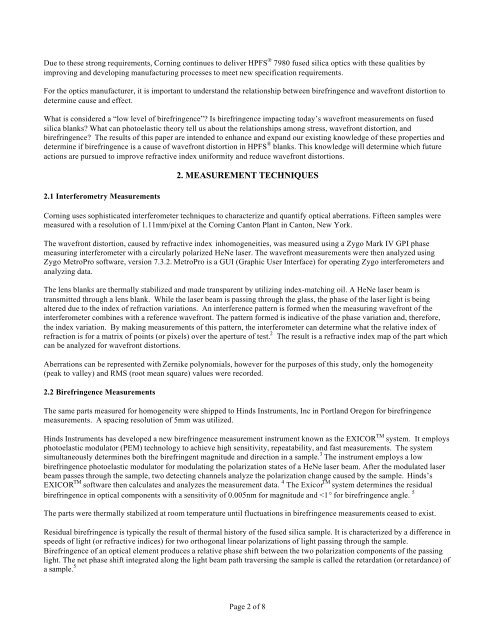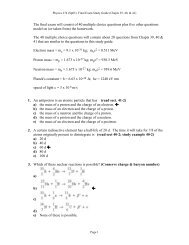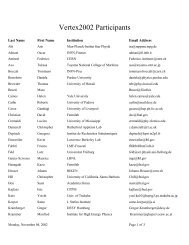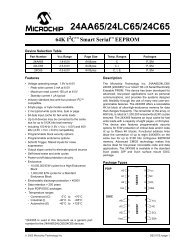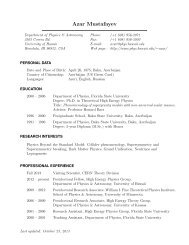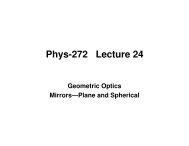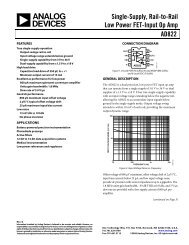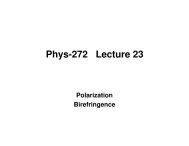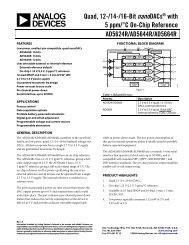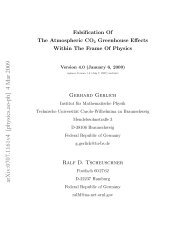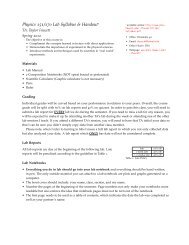Impact of Residual Stress in HPFS Fused Silica
Impact of Residual Stress in HPFS Fused Silica
Impact of Residual Stress in HPFS Fused Silica
You also want an ePaper? Increase the reach of your titles
YUMPU automatically turns print PDFs into web optimized ePapers that Google loves.
Due to these strong requirements, Corn<strong>in</strong>g cont<strong>in</strong>ues to deliver <strong>HPFS</strong> ® 7980 fused silica optics with these qualities by<br />
improv<strong>in</strong>g and develop<strong>in</strong>g manufactur<strong>in</strong>g processes to meet new specification requirements.<br />
For the optics manufacturer, it is important to understand the relationship between birefr<strong>in</strong>gence and wavefront distortion to<br />
determ<strong>in</strong>e cause and effect.<br />
What is considered a “low level <strong>of</strong> birefr<strong>in</strong>gence”? Is birefr<strong>in</strong>gence impact<strong>in</strong>g today’s wavefront measurements on fused<br />
silica blanks? What can photoelastic theory tell us about the relationships among stress, wavefront distortion, and<br />
birefr<strong>in</strong>gence? The results <strong>of</strong> this paper are <strong>in</strong>tended to enhance and expand our exist<strong>in</strong>g knowledge <strong>of</strong> these properties and<br />
determ<strong>in</strong>e if birefr<strong>in</strong>gence is a cause <strong>of</strong> wavefront distortion <strong>in</strong> <strong>HPFS</strong> ® blanks. This knowledge will determ<strong>in</strong>e which future<br />
actions are pursued to improve refractive <strong>in</strong>dex uniformity and reduce wavefront distortions.<br />
2.1 Interferometry Measurements<br />
2. MEASUREMENT TECHNIQUES<br />
Corn<strong>in</strong>g uses sophisticated <strong>in</strong>terferometer techniques to characterize and quantify optical aberrations. Fifteen samples were<br />
measured with a resolution <strong>of</strong> 1.11mm/pixel at the Corn<strong>in</strong>g Canton Plant <strong>in</strong> Canton, New York.<br />
The wavefront distortion, caused by refractive <strong>in</strong>dex <strong>in</strong>homogeneities, was measured us<strong>in</strong>g a Zygo Mark IV GPI phase<br />
measur<strong>in</strong>g <strong>in</strong>terferometer with a circularly polarized HeNe laser. The wavefront measurements were then analyzed us<strong>in</strong>g<br />
Zygo MetroPro s<strong>of</strong>tware, version 7.3.2. MetroPro is a GUI (Graphic User Interface) for operat<strong>in</strong>g Zygo <strong>in</strong>terferometers and<br />
analyz<strong>in</strong>g data.<br />
The lens blanks are thermally stabilized and made transparent by utiliz<strong>in</strong>g <strong>in</strong>dex-match<strong>in</strong>g oil. A HeNe laser beam is<br />
transmitted through a lens blank. While the laser beam is pass<strong>in</strong>g through the glass, the phase <strong>of</strong> the laser light is be<strong>in</strong>g<br />
altered due to the <strong>in</strong>dex <strong>of</strong> refraction variations. An <strong>in</strong>terference pattern is formed when the measur<strong>in</strong>g wavefront <strong>of</strong> the<br />
<strong>in</strong>terferometer comb<strong>in</strong>es with a reference wavefront. The pattern formed is <strong>in</strong>dicative <strong>of</strong> the phase variation and, therefore,<br />
the <strong>in</strong>dex variation. By mak<strong>in</strong>g measurements <strong>of</strong> this pattern, the <strong>in</strong>terferometer can determ<strong>in</strong>e what the relative <strong>in</strong>dex <strong>of</strong><br />
refraction is for a matrix <strong>of</strong> po<strong>in</strong>ts (or pixels) over the aperture <strong>of</strong> test. 2 The result is a refractive <strong>in</strong>dex map <strong>of</strong> the part which<br />
can be analyzed for wavefront distortions.<br />
Aberrations can be represented with Zernike polynomials, however for the purposes <strong>of</strong> this study, only the homogeneity<br />
(peak to valley) and RMS (root mean square) values were recorded.<br />
2.2 Birefr<strong>in</strong>gence Measurements<br />
The same parts measured for homogeneity were shipped to H<strong>in</strong>ds Instruments, Inc <strong>in</strong> Portland Oregon for birefr<strong>in</strong>gence<br />
measurements. A spac<strong>in</strong>g resolution <strong>of</strong> 5mm was utilized.<br />
H<strong>in</strong>ds Instruments has developed a new birefr<strong>in</strong>gence measurement <strong>in</strong>strument known as the EXICOR TM system. It employs<br />
photoelastic modulator (PEM) technology to achieve high sensitivity, repeatability, and fast measurements. The system<br />
simultaneously determ<strong>in</strong>es both the birefr<strong>in</strong>gent magnitude and direction <strong>in</strong> a sample. 3 The <strong>in</strong>strument employs a low<br />
birefr<strong>in</strong>gence photoelastic modulator for modulat<strong>in</strong>g the polarization states <strong>of</strong> a HeNe laser beam. After the modulated laser<br />
beam passes through the sample, two detect<strong>in</strong>g channels analyze the polarization change caused by the sample. H<strong>in</strong>ds’s<br />
EXICOR TM s<strong>of</strong>tware then calculates and analyzes the measurement data. 4 The Exicor TM system determ<strong>in</strong>es the residual<br />
birefr<strong>in</strong>gence <strong>in</strong> optical components with a sensitivity <strong>of</strong> 0.005nm for magnitude and


